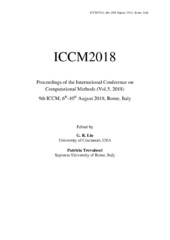Приказ основних података о документу
The topological principles in the contemporary architectural design process
| dc.creator | Lojanica, Vladimir | |
| dc.creator | Dragišić, Maja | |
| dc.date.accessioned | 2023-12-26T13:40:37Z | |
| dc.date.available | 2023-12-26T13:40:37Z | |
| dc.date.issued | 2018 | |
| dc.identifier.issn | 2374-3948 | |
| dc.identifier.uri | https://raf.arh.bg.ac.rs/handle/123456789/1914 | |
| dc.description.abstract | Continuing a chronological line of mutual influences of architecture and geometry, where geometry is perceived as an inextricable part of the syntax of architectural space, this paper focuses on the clarification of a specific position which mathematical topology takes within contemporary architectural discourse. The understanding of topology within architectural design process is based on the mathematical theoretical framework in which the term of continuous deformation of geometric shapes is specified, whose subsequent occurrence in architectural creative work is linked to the increasing use of digital tools in design process and the shift of the dominant philosophical influences in architectural theoretical research. In order to completely perceive the topological method, the theoretical framework ranges between the area of architectural theory of form and architectural design theory, firstly through the explanation of three basic design principles of topological method: deformability, openness and continuity, and secondly through the representation of the models through which the principles occur in the architectural design process. The first part of this work will introduce and analyse the transition of concepts of deformability, openness and continuity, from mathematical topology through philosophy to architecture emphasizing the computational shift in architectural design, while the second part of the work will explain the modalities through which the principles are applied in several architectural design practices. Generally, the paper is conducted in order to determine whether the development of the topological method, as a creative tendency, resulted in forming a unique design strategy due to transformations and adaptations through some authorial design approaches. The topological method design strategy, which involves a complete design approach, is identified as a result of an in-depth research of distinguished methods through three case studies, taking into consideration the complexity of topology within the mathematical area and a complex transition towards the area of architectural theory. The final question returns to the primarily theoretical framework, seeking to set operating platform for development and use of three strategic principles, which simultaneously indicate the possible directions of future development. | sr |
| dc.language.iso | en | sr |
| dc.publisher | Scientech Publisher LLC, USA | sr |
| dc.rights | openAccess | sr |
| dc.source | Proceedings of the 9th International Conference on Computational Methods, 6th-10th August 2018, Rome | sr |
| dc.subject | topology | sr |
| dc.subject | deformation | sr |
| dc.subject | continuity | sr |
| dc.subject | openness | sr |
| dc.subject | digital tools | sr |
| dc.subject | design theory | sr |
| dc.subject | design methodology | sr |
| dc.title | The topological principles in the contemporary architectural design process | sr |
| dc.type | conferenceObject | sr |
| dc.rights.license | ARR | sr |
| dcterms.abstract | Лојаница, Владимир; Драгишић, Маја; | |
| dc.citation.volume | 5 | |
| dc.citation.spage | 752 | |
| dc.citation.epage | 766 | |
| dc.identifier.fulltext | http://raf.arh.bg.ac.rs/bitstream/id/6651/ICCM2018-Proceedings.pdf | |
| dc.identifier.rcub | https://hdl.handle.net/21.15107/rcub_raf_1914 | |
| dc.type.version | publishedVersion | sr |

